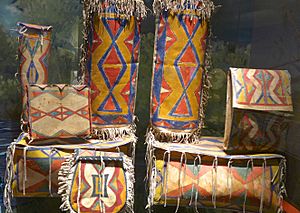Parfleche facts for kids

A parfleche is a special container made by Native American people. It is crafted from rawhide, which is animal skin that has not been tanned. These containers are often decorated with paint or carvings.
Parfleches usually look like envelopes. They were used to carry important things. People stored household tools, dried meat, or pemmican (a type of dried food) inside them. Often, parfleches were made in pairs. They would hang from saddles when people traveled. Some designs on them might have even been like maps! Today, parfleches are still used. They can have special meanings, or be part of dance outfits and parade clothes.
These bags are known for their unique artwork. The designs are often geometric shapes. They can represent things like rivers and mountains. In the past, women were the main artists who made parfleches. They would paint the stretched-out rawhide first. Then they would shape it into the final container. Today, both women and men create these beautiful items.
Contents
What is a Parfleche?
Long ago, many Plains Indians tribes started using horses more. This meant they moved around a lot. They needed good ways to carry their belongings. Things like food, clothes, medicines, and special ceremony items had to be moved easily. Parfleches were perfect because they were light and kept things safe from the weather.
Most parfleches were flat, folded envelopes. But they also came in other shapes. Some were flat cases with laces. Others were cylinders or even trunks.
Making parfleche bags became less common for a while. This happened when many buffalo were hunted almost to extinction. The US government also forced Indigenous peoples to move to reservations. Even so, some tribes, like the Nez Perce, kept hunting and making parfleches. This continued through the 1900s. Today, the Niisitapi and Lakota people still make parfleches.
Where Did the Name "Parfleche" Come From?
The name "parfleche" was first used by French fur traders. They were working in the area where these containers were made. The word comes from two French words: parer which means "to parry" or "to defend," and flèche which means "arrow."
At first, "parfleche" was also used for tough rawhide shields. These shields could "parry" or block arrows. But later, the name was mostly used for these decorated rawhide containers. Different Indigenous peoples have their own names for these useful packages. For example, the Cheyenne call them ho'sēō'o. The Apsáalooke call them bishkisché. And the Hinono'eino call them ho'úwoonó3.
How Parfleches Are Made
In the past, almost all parfleches were made by women. The process started with "fleshing." This means removing the skin from animals. Elk, deer, and most often, buffalo hides were used.
Craftswomen used special bone tools to scrape the hide clean. The hide was stretched out and staked above the ground. Then it was scraped until it was an even thickness. A sticky liquid was put on the hide to protect it. This liquid was made from prickly pear cactus juice or animal glue. This was done before the moist hide was painted.
Until the 1890s, natural paints were used a lot. Black paint came from charcoal. Green came from algae. Yellow and red came from ochre, which is a type of earth. Artists had to paint quickly and carefully. They couldn't easily fix mistakes on the parfleche design.
Once the paint was dry, the women removed hair from the other side of the hide. They used a "stoning" method for this. Then, they cut the shape of the parfleche. They used a flint or metal knife. Finally, the container was folded into its chosen shape. Holes were cut or burned to add ties and laces.
Talented Craftswomen
Historically, Native women who were skilled at making parfleches were highly respected. They were also good at creating painted designs and similar items. These women often formed local guilds. Guilds are like groups of skilled workers. Elders in these groups made sure the skills were kept alive. They also taught younger women.
These guilds helped keep parfleche designs similar across many different tribes. They passed down the traditional designs, symbols, meanings, and techniques.
Many parfleches have been collected and admired as art. But the names of the women who created them in the 1800s are often unknown. These artists were famous in their own communities. However, people like colonial anthropologists and museum curators often didn't record their names.

